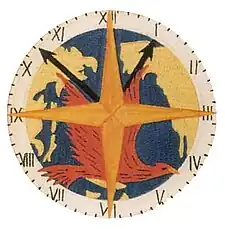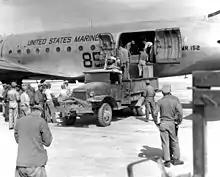| Marine Transport Squadron 152 | |
|---|---|
 VMR-152 insignia (post-WWII) | |
| Active | 1922[1] - 31 Jan 1959[2] |
| Country | United States |
| Allegiance | United States of America |
| Branch | United States Marine Corps |
| Type | Utility/Transport |
| Role | Assault support |
| Part of | Inactive |
| Tail Code | WC |
| Engagements | World War II * Battle of Guadalcanal * New Georgia Campaign * Battle of Vella Lavella * Bougainville Campaign * Philippines Campaign (1944-1945) * Operation Beleaguer Korean War * Battle of Chosin Reservoir |
| Decorations | Distinguished Unit Citation Navy Unit Commendation |
| Commanders | |
| Notable commanders | John P. Coursey |
| Aircraft flown | |
| Transport | R4D R5D Skymaster R4Q Flying Boxcar |
Marine Transport Squadron 152 (VMR-152) was an air transport squadron of the United States Marine Corps that was responsible for the movement of personnel, equipment, and supplies. The squadron flew fixed-wing cargo aircraft to include the R4D Skytrain and the R4Q Flying Boxcar. The squadron saw combat during World War II and the Korean War with their most notable contributions coming during the Battle of Guadalcanal and during the Marine breakout during the Battle of Chosin Reservoir. The squadron was decommissioned in the late 1950s.
Mission
Provide air transport of personnel, equipment, and supplies, including aeromedical evacuation.
History
World War II
The squadron was originally formed as VJ-6M at Marine Corps Air Station Quantico, Virginia in 1922.[1] Re-designation as VMJ-1 came on July 1, 1937, and again as VMJ-152 on July 7, 1941.[3] VMJ-152 became the first Marine Corps squadron to field the new R4D-1 aircraft in the first part of 1942.[4] The squadron subsequently moved to San Diego a few months later and shipped out to the South Pacific on October 10, 1942. The unit joined Marine Aircraft Group 25 on October 25, 1942, and immediately began flying missions in support of Marines engaged in the Battle of Guadalcanal.[5]
In November 1942, the squadron became part of the joint-service South Pacific Combat Air Transport Command. Following this they made numerous supply drops during the New Georgia Campaign in 1943. The squadron was re-designated again to VMR-152 on June 3, 1944.[3] During 1944, the squadron flew in support of operations on Bougainville and remained based there for the remainder of the war. From here the squadron also supported allied forces during the Philippines Campaign (1944–45) and the Battle of Okinawa. Following the surrender of Japan, the squadron flew in support of the 1st Marine Division during their occupation of Northern China from 1945 - 1947. Following their China duty the squadron returned to the United States where they were based at Marine Corps Air Station El Toro, California.

Korean War & Decommissioning
VMR-152 was assigned to newly reactivated Marine Aircraft Group 25 in 1950, and provided an advance detachment that supported 1st Marine Division operations in Korea. During the war the squadron was based at Itami, Japan.
During the Battle of Chosin Reservoir, a four-engined R5D-2 transport, especially configured to carry a complete tactical air direction center (TADC), controlled all support aircraft as they reported on station, and assigned them to the various forward air controllers, as appropriate for the missions requested.
VMR-153 (VMR-152?) was decommissioned on January 31, 1959.[2]
See also
Notes
- 1 2 Rottman 2002, pp. 441.
- 1 2 "Index for 1959 United States Marine Corps Bound Diaries". National Archives Catalog. United States Marine Corps. p. 22. Retrieved 2022-01-26.
- 1 2 Sherrod 1952, pp. 459.
- ↑ Shettle 2001, pp. 131.
- ↑ Armstrong 2017, pp. 7.
References
 This article incorporates public domain material from websites or documents of the United States Marine Corps.
This article incorporates public domain material from websites or documents of the United States Marine Corps.
- Bibliography
- Armstrong, William (2017). Marine Air Group 25 and SCAT. Arcadia Publishing. ISBN 1467127434.
- Rottman, Gordon (2002). U.S. Marine Corps World War II Order of Battle - Ground and Air Units in the Pacific War, 1939 - 1945.’’. Greenwood Press. ISBN 0-313-31906-5.
- Sherrod, Robert (1952). History of Marine Corps Aviation in World War II. Washington, D.C.: Combat Forces Press.
- Shettle, M. L. (2001). United States Marine Corps Air Stations of World War II. Bowersville, Georgia: Schaertel Publishing Co. ISBN 0-9643388-2-3.
- Web
